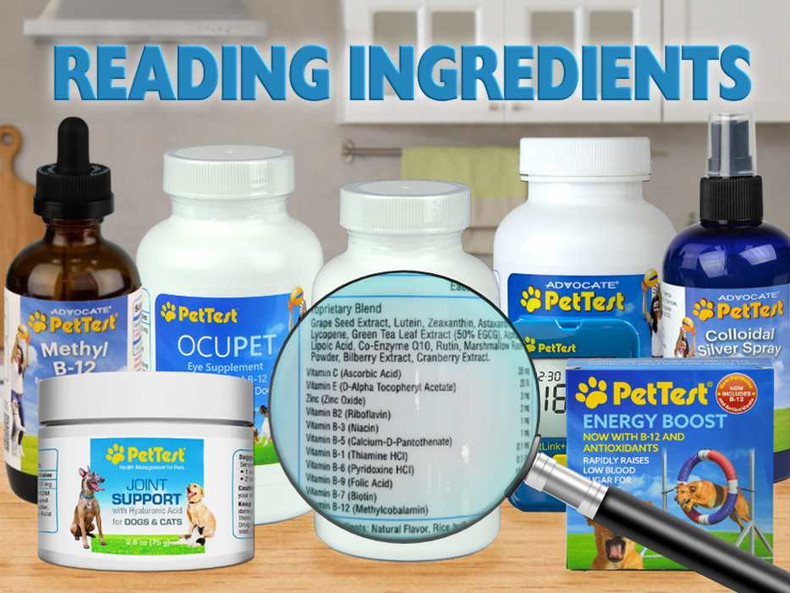Reading Ingredients
After Lucy was diagnosed with diabetes and pancreatitis I started reading the ingredients in foods and treats since I needed to ensure that she was eating low-fat foods. I also needed to make sure that what she was eating wasn’t carbohydrates heavy; since there are simple carbohydrates and complex carbohydrates, I made sure that her meals had the lowest amounts of simple carbs possible and her treats had zero simple carbs.
I also started giving Lucy supplements to aid in her overall health. Hip and joint, eye, digestive enzymes, methyl B12, etc., etc., etc. I had to look up the ingredients/inactive ingredients to ensure that they were safe to give her and I found that there are a lot of canine supplements that have ingredients that can spike blood glucose levels and should not be given to a diabetic. A prime example is maltodextrin; it is used often in the food industry as a thickener or filler, or as a preservative and has been found in a lot of supplements for dogs as well. I am not a fan of maltodextrin at all because it is higher on the glycemic index than white sugar, white sugar is 68 on the glycemic index and maltodextrin is 105 – 185 (per sciencedirect.com).
There can be a lot of fillers or binders in supplements, but the most common are:
Brewer’s yeast – contains B vitamins and trace minerals and may be included in a supplement to boost vitamin/mineral content. Also used as a binder. May raise blood glucose levels but quantities per serving may be low enough that blood glucose effect is nominal or negligible.
Glycerin (vegetable, coconut) – used as a preservative and should not raise blood glucose levels.
Tapioca – used as a thickener and filler; will raise blood glucose levels as it is a starch. Tapioca is used in dog food as well.
Flours – used as a binder and will raise blood glucose levels. Most commonly found in treats and soft chew supplements.
Maltodextrin – used as a filler, thickener, preservative, improve texture and used as a sugar replacement. Should be avoided due to very high glycemic index.
Sugars (dextrose, molasses, cane syrup, corn syrup, brown rice syrup, glucose, lactose, sugar) – flavor enhancer and should be avoided unless treating for hypoglycemia.
Below is a list of additives commonly found in canine supplements/medications that can be printed for future use. Just click on the pic to take you to a printable PDF.
Of course there are additional additives that are not listed; these are the most common additives I have come across when reviewing ingredients.
I hope this list helps you when looking for supplements, medications or treats for your dog. If you see an additive that is not listed please let me know and I will add it to the list!
If you have any questions, comments or suggestions, please start a conversation below.
For a printable version of this blog click here.
Until next week stay comfy, don’t stress and you got this!
Michelle Miller-Matlock
AAHA Certified Diabetes Educator
Founder/Administrator of DDO: Diabetic Dog Owners University
Administrator of Diabetic Dog Owners on Facebook
Want to learn all you can in a simple and easy to follow format? Please join DDO-U: Diabetic Dog Owners University , graciously sponsored by PetTest.
Be sure to join the PetTest family on Facebook and Instagram. PetTest has fun, interactive posts AND they have fabulous giveaways every week!
Do you need a blood glucose meter kit for your diabetes arsenal? Click here to purchase one if you live in the USA. Click here to purchase a meter kit if you live in Canada.
PetTest USA link: https://shoppettest.com/
Link to PetTest Canada: https://pettest.ca/
If you live in Australia, Wantsa Medical offers PetTest products.
UK residents can purchase PetTest Supplies from Home Health UK.
New Zealand now has PetTest products through VetPost.
Don’t forget to check your email for the latest PetTest promo codes and if you aren’t subscribed to receive PetTest emails sign up now. You can also go to PetTest on Facebook or Instagram for current promo code info.


